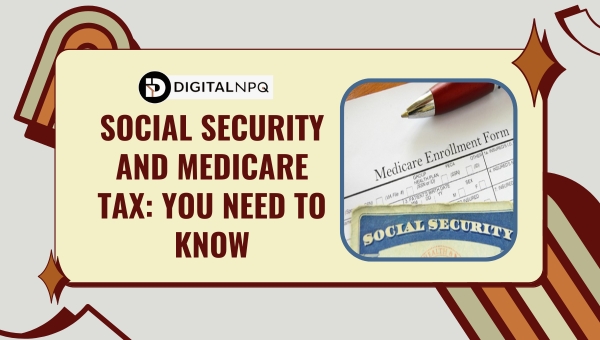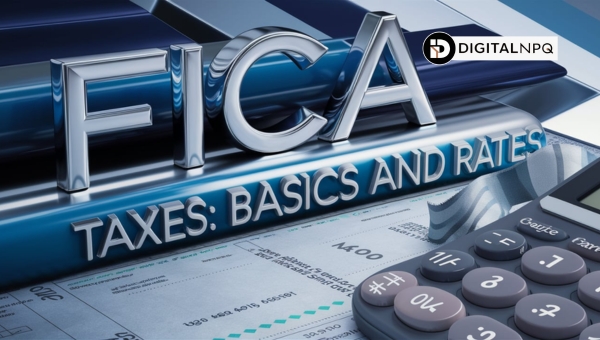Social Security and Medicare Tax: You Need to Know

Are you looking to understand Social Security and Medicare tax better? Look no further! In this comprehensive guide, we’ll delve into the basics and rates of FICA taxes, explore wage base limits, and explain additional Medicare tax withholding. We’ll also provide an overview of withholding tax and self-employment tax, including rates, deductions, and who must pay.
Furthermore, we’ll outline the steps to pay self-employment tax and discuss common exemptions and special cases. Lastly, we’ll guide you on what to do if you overpay FICA taxes. By the end of this article, you’ll have a clear grasp of Social Security and Medicare tax, empowering you to navigate your tax responsibilities with confidence.
FICA Taxes: Basics and Rates
FICA, which stands for Federal Insurance Contributions Act, includes both Social Security and Medicare taxes. These taxes are crucial as they fund essential programs that provide benefits for retirees, disabled individuals, and children of deceased workers.

Let’s delve into the specifics of FICA taxes, including the current tax rates, wage base limits, and additional withholding requirements for Medicare.
FICA Tax Rate 2023
The FICA tax rate for 2023 is split between Social Security and Medicare taxes. Here’s a breakdown:
- Social Security Tax: 6.2% for both the employer and employee.
- Medicare Tax: 1.45% for both the employer and employee.
- Total FICA Tax Rate: 7.65% each for the employer and employee, amounting to 15.3% collectively.
Wage Base Limits for FICA Taxes
The wage base limits determine the maximum amount of earnings subject to Social Security tax. For 2023:
- Social Security Wage Base Limit: $160,200. This means Social Security tax only applies to the first $160,200 of an employee’s earnings.
- Medicare Tax: There is no wage base limit for Medicare tax, meaning all earnings are subject to this tax.
Additional Medicare Tax Withholding
The Additional Medicare Tax is an extra tax that applies to high-income earners. Detailed information on this tax includes:
- Thresholds for Additional Medicare Tax:
- Single Filers: Earnings over $200,000.
- Married Filing Jointly: Earnings over $250,000.
- Married Filing Separately: Earnings over $125,000.
- Rate of Additional Medicare Tax: An extra 0.9% on earnings exceeding the thresholds mentioned above.
Employers are responsible for withholding this additional tax once an employee’s earnings exceed $200,000, regardless of their filing status.
If you’re married and your combined income surpasses the threshold, but individually you don’t exceed $200,000, you’ll need to account for this when filing your tax return. This tax is only paid by employees; employers do not match it.
Understanding these elements of FICA taxes is essential for both employers and employees. Navigating these details ensures compliance and helps in accurate financial planning.
Understanding Withholding Tax
Withholding tax is an income tax that an employer deducts from an employee’s paycheck and sends directly to the government.

This process ensures that employees pay their taxes incrementally throughout the year, rather than all at once during tax season.
How does withholding tax function?
- Calculation: The amount withheld is based on the employee’s income, filing status, and the information provided on their W-4 form. The more allowances claimed on the W-4, the less tax is withheld.
- Payroll Process: Each pay period, employers calculate the withholding tax based on the employee’s earnings and the current tax rates. This amount is then deducted from the employee’s gross pay.
- Remittance: Employers are responsible for submitting the withheld taxes to the IRS and other relevant tax agencies. This is typically done on a monthly or semi-weekly basis, depending on the size of the payroll.
- Tax Credits and Refunds: At the end of the year, employees file their tax returns. If too much tax has been withheld, they receive a refund. If too little has been withheld, they owe additional taxes.
It is important to note that withholding tax not only applies to federal income tax but also to state and local taxes, where applicable. Proper withholding helps prevent large tax bills or penalties at the end of the year.
Understanding withholding tax is crucial for both employees and employers to ensure compliance with tax laws and to manage finances effectively.
Self-Employment Tax Overview
Navigating the world of self-employment can be both exciting and challenging. One crucial aspect that every self-employed individual must understand is the self-employment tax.

This involves understanding the tax rates, available deductions, and determining who must pay this tax. Let’s delve into each of these aspects to ensure you have a comprehensive understanding.
Self-Employment Tax Rate
When it comes to self-employment, taxes can seem daunting, but knowing the rates can make it more manageable.
- Social Security Tax: 12.4% of your net earnings.
- Medicare Tax: 2.9% of your net earnings.
- Additional Medicare Tax: For those with income over certain thresholds, an additional 0.9% applies.
Together, this makes the total self-employment tax rate 15.3%, with the additional Medicare tax applying to higher income levels.
Self-Employment Tax Deduction
Self-employed individuals are allowed to deduct a portion of their self-employment tax when filing their income tax return.
Here are some key points:
- Deductible Portion: You can deduct half of your self-employment tax.
- Reason for Deduction: This deduction accounts for the employer-equivalent portion of your self-employment tax.
- Effect on Income: This deduction reduces your adjusted gross income, which can lower your overall tax liability.
This deduction is essential as it helps ease the tax burden on self-employed individuals.
Who Must Pay Self-Employment Tax?
Determining who must pay self-employment tax is straightforward but vital for compliance. Here are the criteria:
- Net Earnings Requirement: If your net earnings from self-employment are $400 or more, you must pay self-employment tax.
- Types of Income: This includes earnings from freelance work, business ownership, and other self-employment activities.
- Exemptions: Certain groups, such as certain nonresident aliens and members of specific religious groups, may be exempt.
Understanding these criteria ensures that you stay compliant and avoid potential penalties.
Also Read: CTC Payments 2024: Maximize Your Child Tax Credit
How to Pay Self-Employment Tax?
Paying self-employment tax can seem complex, but following a clear set of steps can simplify the process. Here’s a concise guide to help you navigate:
- Estimate Your Taxable Income:
- Calculate your net earnings from self-employment. This is your total income minus any business expenses. Accurate record-keeping is crucial here to ensure you report the correct amount.
- Calculate Self-Employment Tax:
- Apply the self-employment tax rate to your net earnings. For 2023, this rate is 15.3% (12.4% for Social Security and 2.9% for Medicare). Remember, if your income exceeds certain thresholds, an additional 0.9% Medicare tax may apply.
- Determine Your Quarterly Payments:
- Self-employed individuals are required to make estimated tax payments quarterly. The deadlines are typically April 15, June 15, September 15, and January 15 of the following year. Missing these dates could result in penalties.
- Complete the Estimated Tax Form:
- Use IRS Form 1040-ES, which includes a worksheet to help you estimate your taxes. This form also provides payment vouchers if you prefer mailing your payments.
- Submit Your Payments:
- Payments can be made directly online through the IRS website using the Electronic Federal Tax Payment System (EFTPS). This method is secure and provides immediate confirmation. Alternatively, you can mail a check or money order along with the payment voucher from Form 1040-ES.
- File Your Annual Tax Return:
- At the end of the year, file your annual tax return using Form 1040. Attach Schedule SE to calculate your self-employment tax and report it. You can also claim deductions such as the self-employment tax deduction, which allows you to deduct half of your self-employment tax from your income.
By following these steps, you can ensure that your self-employment taxes are paid accurately and on time. Proper planning and timely payments will help you avoid any unnecessary penalties.
Common Exemptions and Special Cases
When it comes to Social Security and Medicare taxes, not everyone is required to pay. There are certain exemptions and special cases that can apply, making it important to understand who qualifies.
1. Nonresident Aliens: Some nonresident aliens are exempt from paying FICA taxes. Typically, this includes individuals on specific types of visas, such as F-1, J-1, M-1, or Q-1. These individuals are often students, scholars, or trainees temporarily in the United States.
2. Religious Groups: Members of certain religious groups who are opposed to accepting benefits from Social Security or Medicare due to their beliefs can apply for an exemption. To qualify, the religious group must have a long-standing history of providing for its dependent members and must be recognized by the IRS.
3. Government Employees: Federal, state, and local government employees may also have specific exemptions. For example, some state and local government employees who participate in a public retirement system may be exempt from Social Security taxes but still required to pay Medicare taxes.
4. Family Employment: Employment of children under age 18 by their parents, and employment of parents by their children, may be exempt from FICA taxes. Additionally, work performed by a child under age 21 in a parent’s unincorporated business may also qualify for an exemption.
5. Foreign Government Employees: Individuals working for a foreign government or an international organization in the U.S. are generally exempt from Social Security and Medicare taxes. This exemption is contingent on the employee holding a specific visa status and the employment being official in nature.
It’s essential to be aware of these exemptions and special cases to ensure compliance and potentially save on taxes. Always consult with a tax professional if you’re unsure about your specific situation.
Also Read: Time Change Spring 2024: Everything You Need to Know
Overpaying FICA Taxes: What to Do
Overpaying your FICA taxes can happen, and knowing what steps to take is crucial. If you find yourself in this situation, follow these guidelines to address the issue effectively.
Confirm the Overpayment
- Verify your records: Start by double-checking your pay stubs and W-2 forms to ensure that an overpayment has indeed occurred.
- Compare with limits: Ensure your Social Security contributions do not exceed the annual wage base limit, while Medicare taxes have no such cap.
Steps to Rectify
- Notify your employer: If the overpayment is due to payroll errors, contact your employer’s payroll department immediately. They are often the first point of resolution.
- File for a refund: If the employer is unable to correct the mistake, you can file Form 843, “Claim for Refund and Request for Abatement,” with the IRS.
Filing Form 843
- Complete the form: Provide all necessary details, including the amount of overpayment and the tax periods involved.
- Attach documentation: Include copies of relevant pay stubs, W-2 forms, and any correspondence with your employer.
- Submit to the IRS: Mail the completed Form 843 and supporting documents to the IRS address for your location.
Handling Excess Contributions
- Social Security: If you have multiple employers and your total contributions exceed the wage base limit, you can claim a refund for the excess amount when you file your annual tax return.
- Medicare: For Medicare tax overpayments, the process is similar but typically involves direct employer correction.
Follow-Up
- Track your claim: Keep a record of your Form 843 submission and any responses from the IRS. Follow up if you do not receive a timely acknowledgment or resolution.
- Consult a tax professional: If you face complications, consider seeking advice from a tax advisor to ensure all steps are correctly followed.
By taking these actions, you can efficiently address any overpayment of your FICA taxes and secure the appropriate refund.
FAQs
Do you get Medicare tax back?
No, Medicare taxes are not refundable. These taxes fund the Medicare program, which provides health insurance for individuals aged 65 and older as well as certain younger people with disabilities.
Does everyone pay Medicare taxes?
Yes, most employees and self-employed individuals must pay Medicare taxes. The tax is automatically deducted from your paycheck or included in your self-employment tax.
Can I get a tax refund if my only income is Social Security?
If Social Security is your sole income, you typically will not owe federal income taxes, which means you won’t be eligible for a tax refund. However, if you have other sources of income, you might qualify for a refund depending on your total tax situation.
Conclusion
It is essential for both workers and independent contractors to comprehend Social Security and Medicare taxes. Many people will rely on these taxes to pay for important programs when they retire.
You can guarantee compliance and perhaps save money through deductions and careful planning by understanding the fundamentals of FICA taxes, withholding tax, and self-employment tax. Being aware is the first step in navigating these fiscal seas, which doesn’t have to be intimidating.
If this post was useful to you, check out other thought-provoking blogs on our website to stay educated and in control!
